3
Dr. Evan Freeman

The Byzantine Empire spanned more than a millennium and penetrated geographic regions far from the capital of Constantinople. As a result, Byzantine art includes works created from the fourth century to the fifteenth century and from such diverse regions as Greece, the Italian peninsula, the eastern edge of the Slavic world, the Middle East, and North Africa. So what is Byzantine art and what do we mean when we use this term?
Events from the lives of Jesus Christ and his mother, the Virgin Mary, were among the most frequently depicted subjects in Byzantine art. Many of these events were recorded in the four Gospels in the Christian Bible, but others were also inspired by non-biblical texts, such as the “Protoevangelion of James,” a second-century narrative of the life of the Virgin which was nevertheless read by Byzantines. The Byzantines commemorated these events as church feasts according to the liturgical calendar each year (as does the Eastern Orthodox Church today, which is heir to Byzantium’s religious tradition).
Depictions of these events appeared in a wide range of media, on different scales, and in public and private settings. It would be inaccurate to imply that these scenes were always the same; they varied depending on the circumstances of their production as well as the periods in which they were made. Acknowledging the risk of oversimplifying an artistic tradition that endured for more than a millennium, this essay nevertheless seeks to introduce the stories and common features in Byzantine depictions of the lives of Christ and the Virgin.
Commonly depicted subjects in Byzantine art
| The Birth of the Virgin
The Presentation of the Virgin The Annunciation The Nativity of Christ The Meeting of the Lord The Baptism of Christ The Transfiguration The Raising of Lazarus Entry into Jerusalem The Last Supper |
The Washing of the Feet
The Crucifixion The Deposition The Lamentation The Resurrection The Anastasis The Incredulity of Thomas The Ascension Pentecost The Dormition |
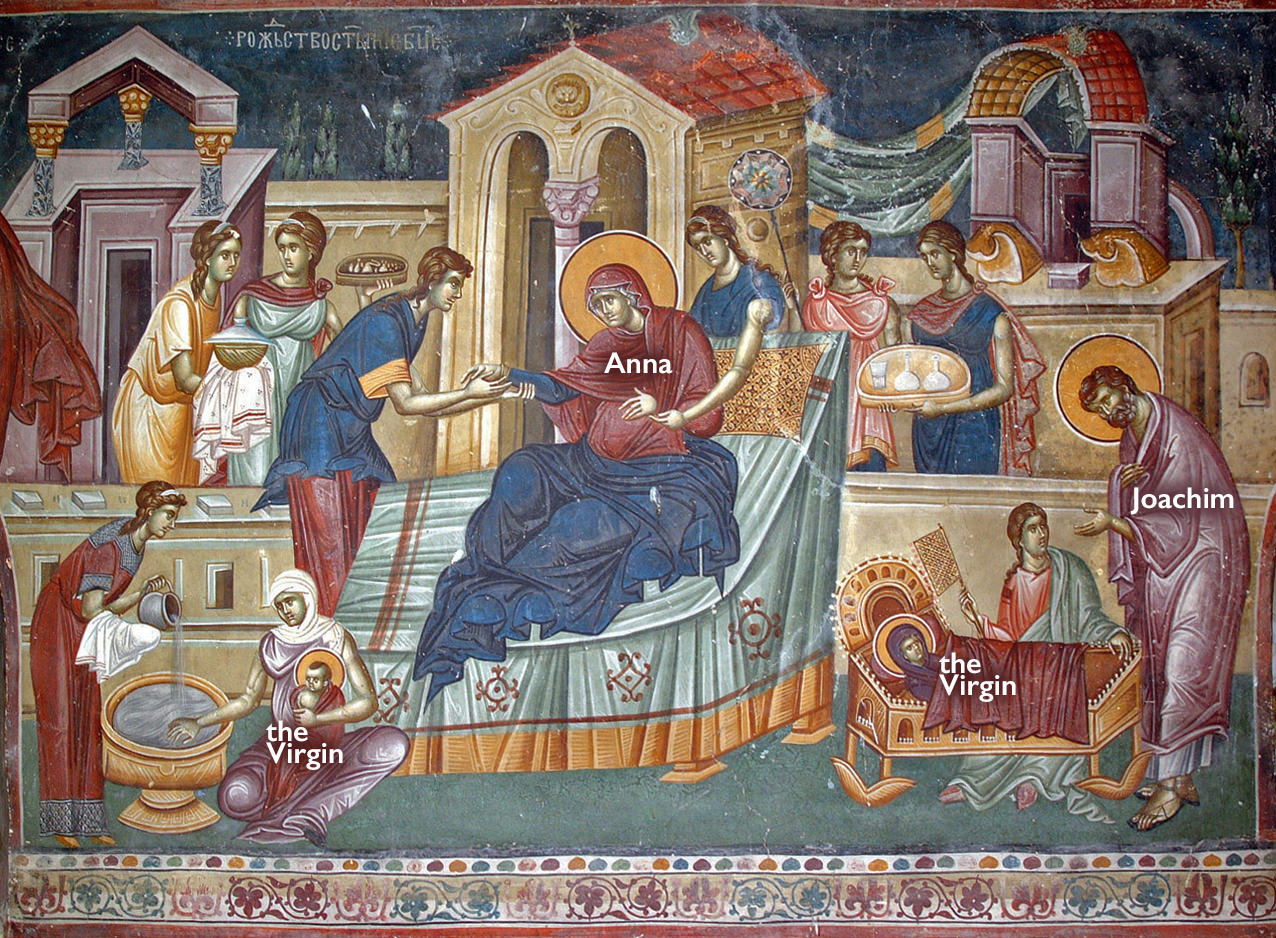
The Birth of the Virgin
Drawn from non-biblical accounts such as the “Protoevangelion of James,” the Birth of the Virgin is commemorated as a Church feast on September 8. Anna, the Virgin’s mother, lies on a bed. Midwives bathe the newborn Mary. Other women bustle about, attending to Anna. Joachim, the Virgin’s father, sometimes appears as well. At Studenica Monastery in Serbia, Joachim stands beside the Virgin as she lies in a cradle after her bath in the lower right.
The Presentation of the Virgin in the Temple
The Presentation of the Virgin in the Temple is based on non-biblical texts and is commemorated on November 21. The Virgin Mary is a child. She processes with her parents, Joachim and Anna, along with several candle-bearing maidens, toward the Jewish temple. Joachim and Anna offer the Virgin to God and the priest Zacharias receives her into the temple. As the narrative continues, Mary dwells within the temple, where an angel feeds her bread. The earliest examples of this image date to the tenth century. The hymnography (the poetic songs sung in Byzantine churches) for the feast emphasizes that the Virgin herself became a temple by allowing God to dwell in her when she conceived Christ. At the Chora Monastery, the procession to the temple takes a circular form to accommodate the vault where it appears (view annotated image below).
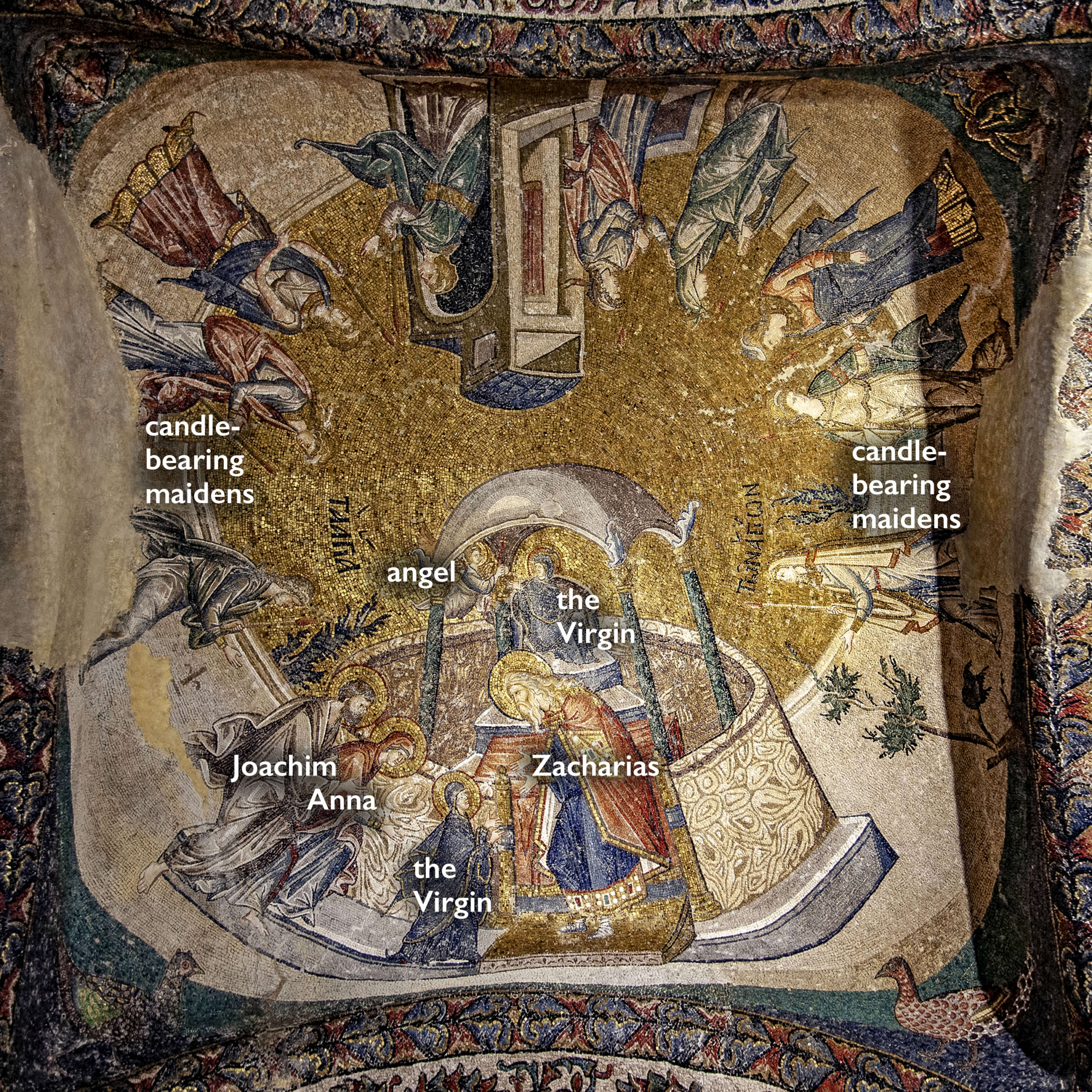

The Annunciation
The Annunciation (Greek: Evangelismos) is recorded in Luke 1:26–38 and commemorated on March 25. Simple compositions, such as the mosaic found at Daphni, show the archangel Gabriel approaching the Virgin Mary to announce that the Holy Spirit will come upon her and that she will conceive the Son of God, Jesus. Other images show the Spirit descending as a dove on a ray of light. Artists sometimes include additional details from a non-biblical text known as the “Protoevangelion of James.” The Virgin may hold scarlet thread to weave a veil for the temple or appear near a well where she is drawing water when the angel approaches.
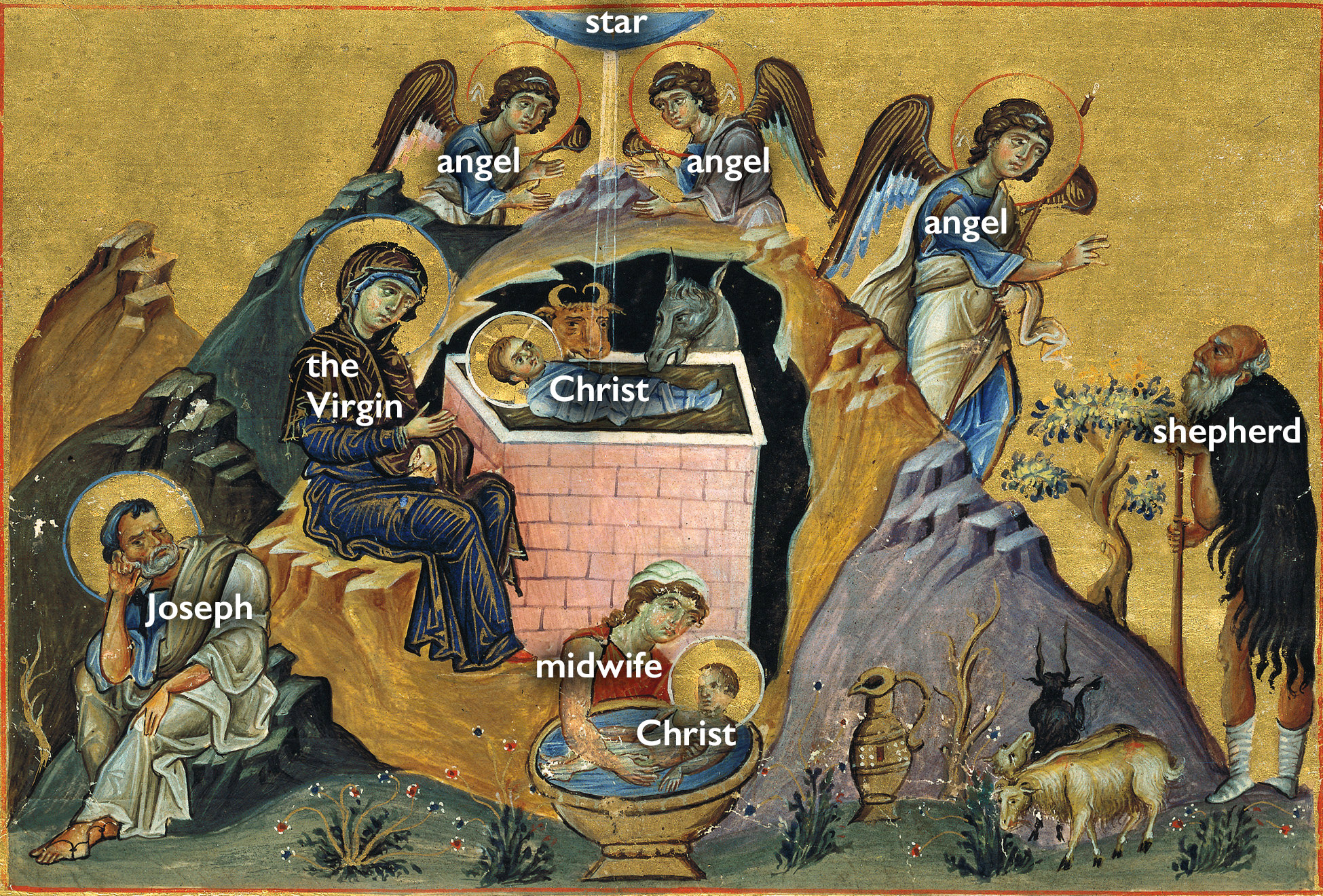
The Nativity of Christ
The Nativity of Christ depicts the birth of Jesus. It is drawn primarily from Matthew 1:18–2:12 and Luke 2:1–20 and is commemorated on December 25. The newborn Christ appears in a manger (a feeding trough for animals) near an ox and ass. The Virgin sits or reclines near Christ, but Joseph is usually relegated to the periphery (appearing in the lower left corner in the miniature from the Menologion of Basil II, a book containing descriptions of saints’ lives and sacred events arranged according to the date of their commemoration in the Church calendar) to minimize his role in the Christ’s birth (emphasizing Mary’s virginity). The narrative continues with one or two midwives bathing Christ. Angels announce the good news to shepherds. The star that guided the Magi (also known as the “wise men” or “three kings”) from the east shines down on the Christ child.
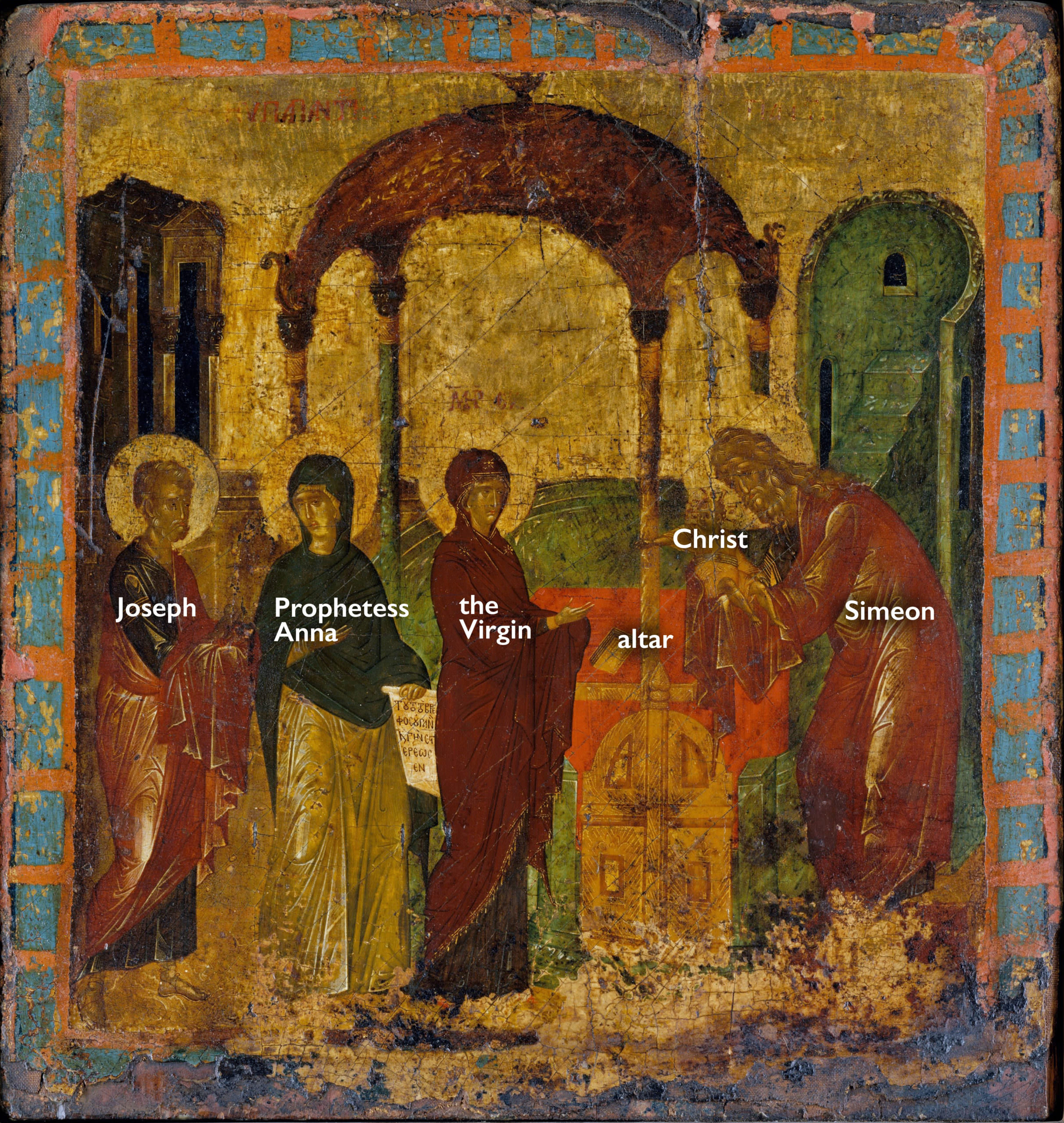
The Meeting of the Lord in the Temple
The Meeting of the Lord in the Temple (Greek: Hypapantē) is described in Luke 2:22–38 and commemorated on February 2. Mary and Joseph enter the Jewish temple to sacrifice two birds and offer Jesus to the Lord, in accordance with the Jewish law. They encounter the prophet Simeon (shown taking the Christ child in his arms in this image from The Metropolitan Museum of Art) and the prophetess Anna, who identify Christ as the Messiah. The temple is often visualized as a Christian church, indicated by a Christian altar and other church furniture.
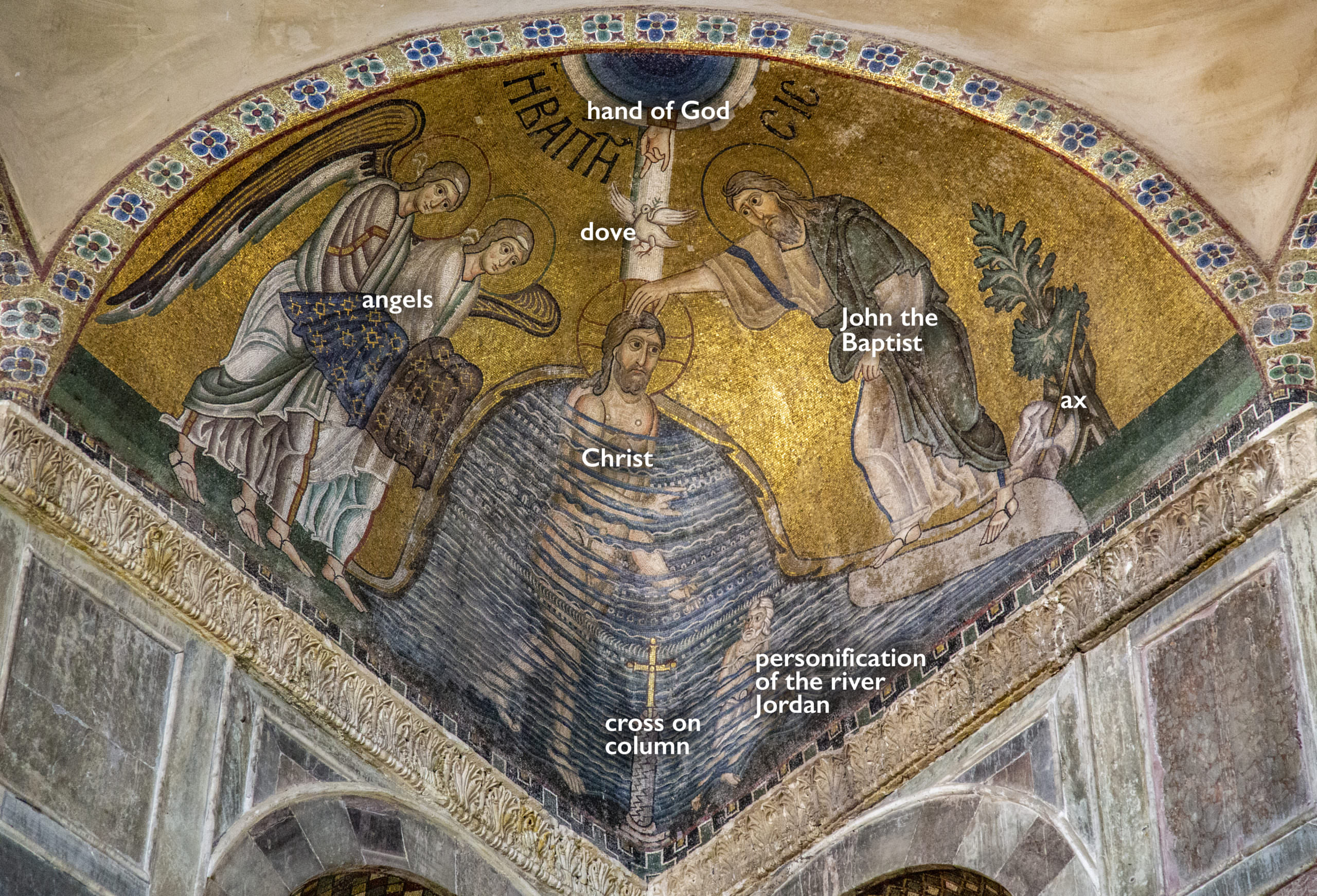
The Baptism of Christ
The Baptism of Christ (sometimes called “Theophany” or “Epiphany”) is recounted in Matthew 3:13–17, Mark 1:9–11, and Luke 3:21–22, and is commemorated by the Eastern Orthodox Church on January 6. John the Baptist, or “Forerunner,” baptizes Christ in the Jordan River, while attending angels stand nearby. The Holy Spirit descends on Christ in the form of a dove, while the words of God the Father identifying Jesus as his Son are represented by a hand blessing from the heavens. An ax appears with a tree, referencing the Baptist’s ominous words, “Even now the ax is lying at the root of the trees; every tree therefore that does not bear good fruit is cut down and thrown into the fire” (Matthew 3:10). Sometimes, as at Hosios Loukas Monastery, the Jordan River is personified as a human figure in the water, corresponding with its personification in the hymnography for the feast. A cross also appears in the water at Hosios Loukas as a reference to the cross and column at the pilgrimage site associated with this event in Palestine, as described by a sixth-century pilgrim named Theodosius.
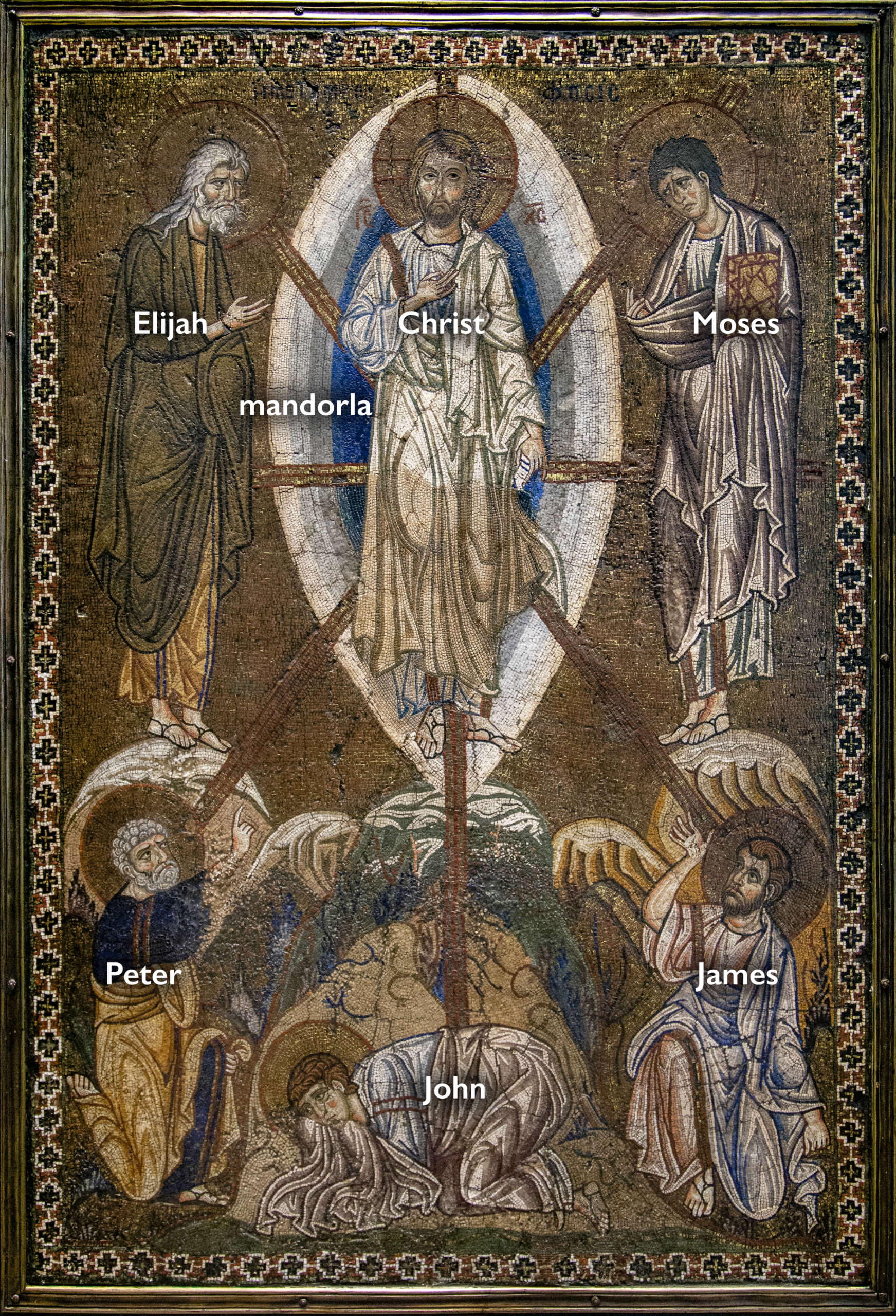
The Transfiguration
The Transfiguration is described in Matthew 17:1–13, Mark 9:2–8, and Luke 9:28–36 and is commemorated on August 6. Jesus ascends a mountain (which tradition identifies as Mount Tabor) with Peter, James, and John (three of his disciples) and is transformed so that he shines with divine light. This light often appears as rays and a mandorla (an almond- or circle-shaped halo of light), as seen in the mosaic icon at the Louvre. Moses and Elijah—two figures representing the law and the prophets from the Hebrew Bible—appear on either side of Christ. Early examples of this motif are found at the Monastery of Saint Catherine at Mount Sinai and Sant’Apollinare in Classe.
The Passion
The Passion (“suffering”) refers to Christ’s sacrificial death on the cross and the period leading up to it. It is commemorated annually during Holy Week, whose dates vary from year to year based on the lunar cycle.
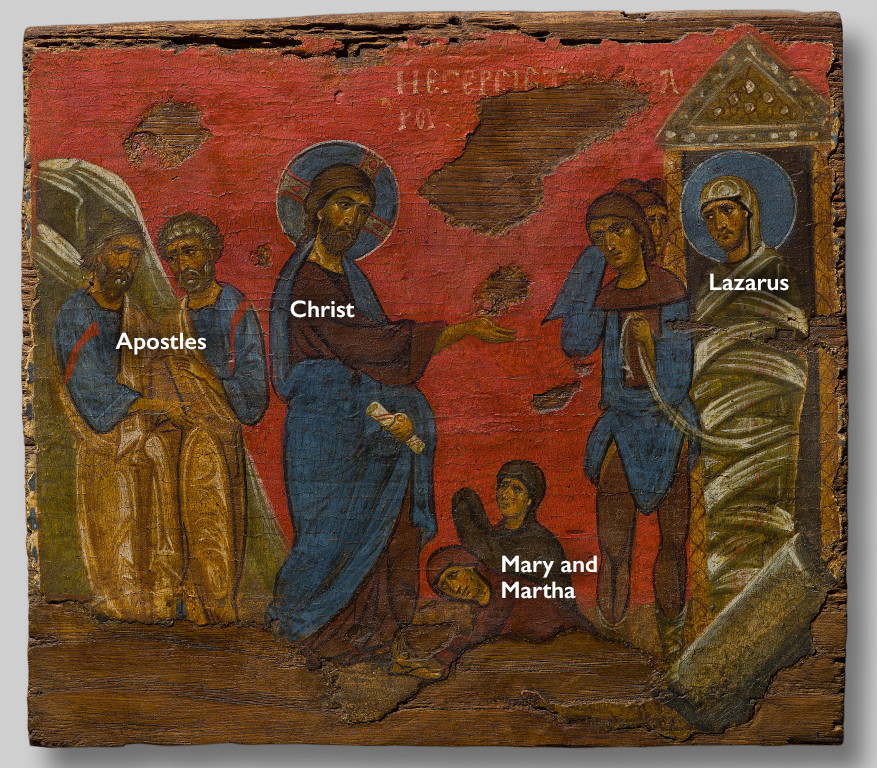
The Raising of Lazarus
The Raising of Lazarus (a friend of Christ’s) from the dead is recorded in John 11:38–44. The Eastern Orthodox Church commemorates this miracle of Christ on the Saturday before Palm Sunday. Christ, trailed by the Apostles, calls forth the shrouded Lazarus from the tomb, as seen in the templon beam fragment in Athens. Mary and Martha, the sisters of Lazarus, kneel at Christ’s feet. Additional figures open the tomb and free Lazarus from his grave clothes. One bystander usually holds his nose because of the stink of Lazarus’s decomposing body.
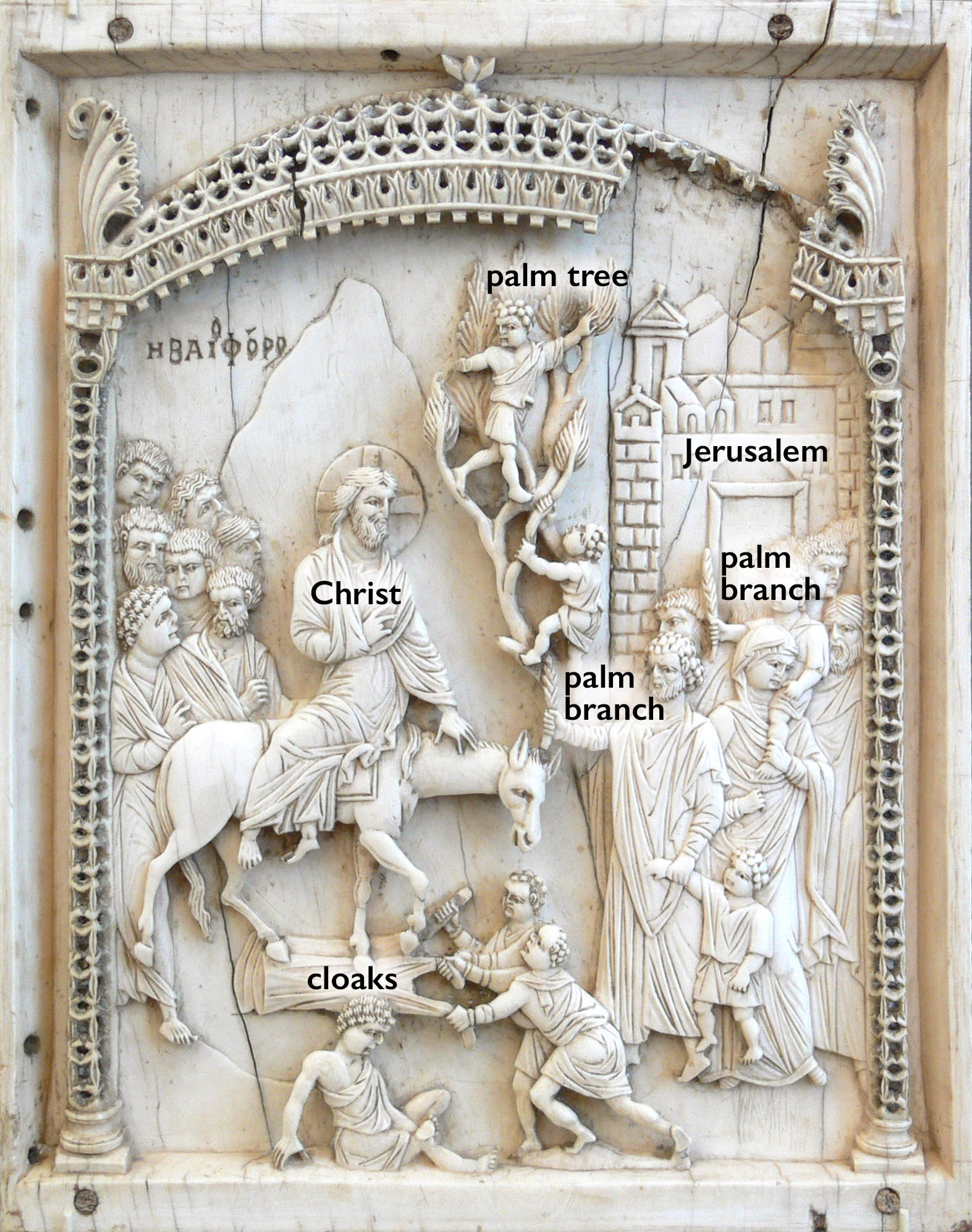
The Entry into Jerusalem
The Entry into Jerusalem is recounted in Matthew 21:1–11, Mark 11:1–10, Luke 19:29–40, and John 12:12–19 and is commemorated on Palm Sunday, the Sunday before Pascha (Easter). Jesus rides into the city of Jerusalem on a donkey. A crowd hails him, throwing cloaks and palms on the road before him. Children often climb among the palm trees, as in the Berlin ivory.
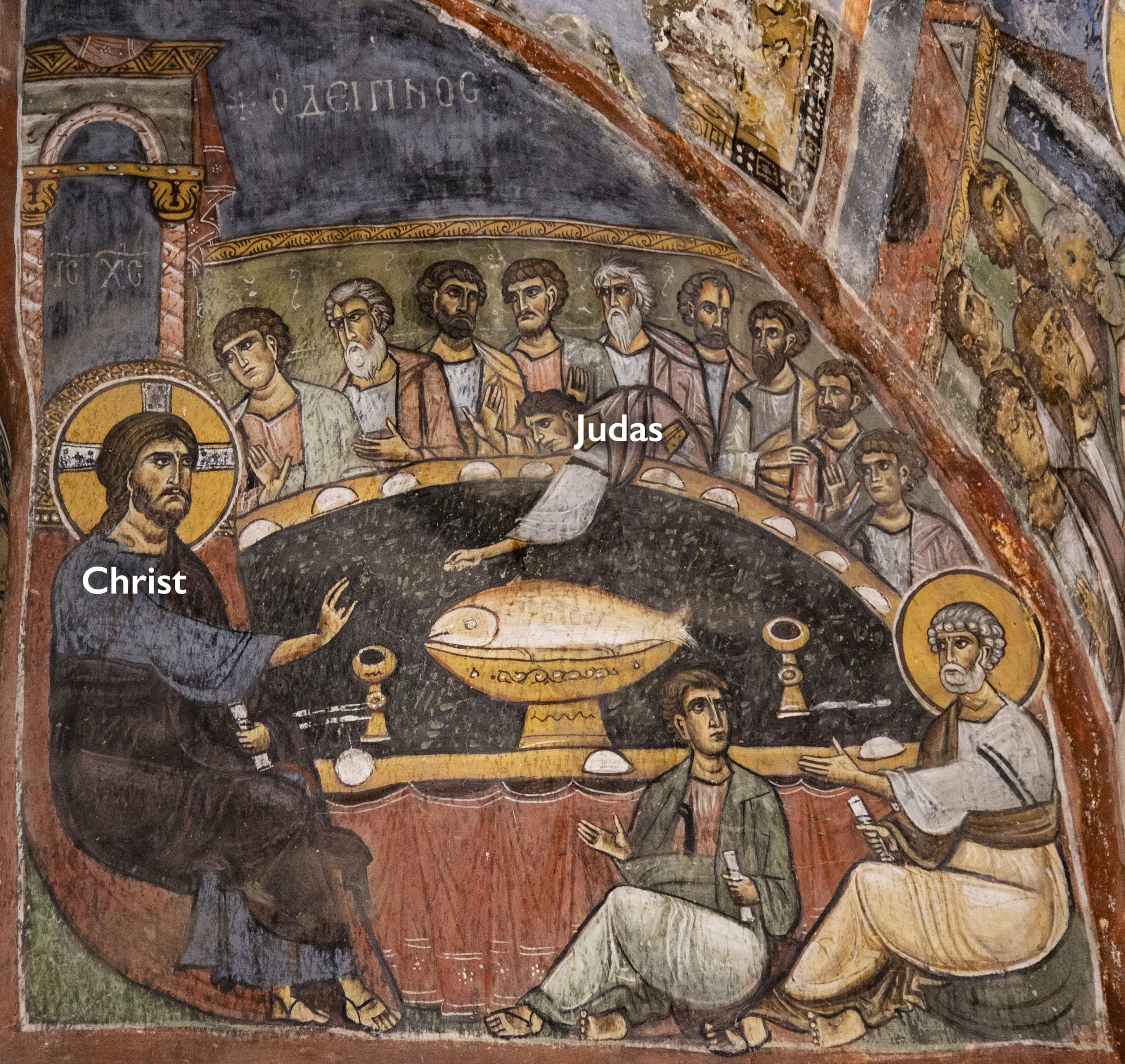
The Last Supper
The Last Supper, “Mystical Supper,” or just “Supper” (Greek: Deipnos), represents the meal that Christ shared with his disciplines before his crucifixion, which is recorded in Matthew 26:20–29, Mark 14:17–25, Luke 22: 14–23, and I Corinthians 11:23–26, and is commemorated on Holy Thursday (known as “Maundy Thursday” in the Latin church). Judas reaches to dip his food in a bowl, which Christ identifies as a sign of betrayal. The table frequently takes the form of a late-antique, C-shaped “sigma” table <https://tinyurl.com/379dd4m6> as at the church of the Panagia Phorbiotissa in Asinou, Cyprus. Often, a large fish appears on the table, which may illustrate the ancient Christian use of the Greek word for “fish” (ichthys) as an acronym for “Jesus Christ, Son of God, Savior.” The Last Supper is typically interpreted as the first celebration of the Eucharist.
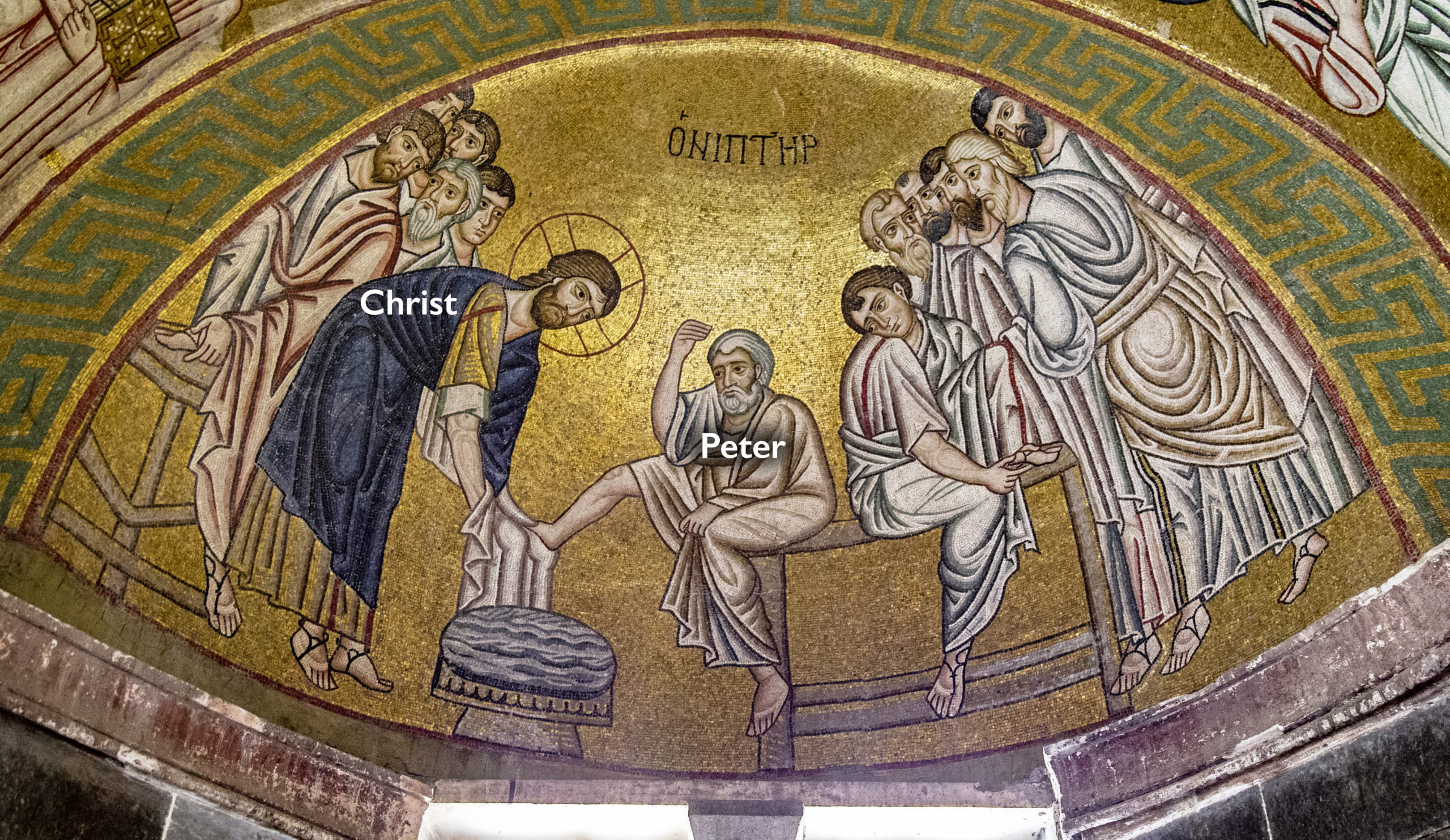
The Washing of the Feet
The Washing of the Feet occurred during the Last Supper, according to John 13:2–15. In the Gospel account, Peter resists letting Jesus wash his feet. But Christ explains: “If I, your Lord and Teacher, have washed your feet, you also ought to wash one another’s feet. For I have set you an example” (John 13:14–15). The mosaic at Hosios Loukas Monastery shows Christ in the act of washing Peter’s feet.
The Crucifixion
The Crucifixion depicts Christ’s death on the cross, described Matthew 27:32-56, Mark 15:21-41, Luke 23:26-49, John 19:16-37, and commemorated on Holy Friday (known as “Good Friday” in the west) during Holy Week. Simpler representations of the scene include the Virgin and John the Evangelist, illustrating John’s account. The sun and moon or angels appear in the sky above. More complex compositions, such as that found on a templon beam at Sinai, incorporate other women who followed Christ as well as Roman soldiers, such as Saint Longinus who converted to Christianity. John recounts how one of the soldiers pierced Christ with a spear, spilling blood and water from his side (John 19:34-35). The event unfolds at Golgotha, the “Place of the Skull,” outside of the city walls of Jerusalem (which sometimes appear in the background). Some depictions of this scene include a skull at the foot of the cross, which tradition identifies as the skull of Adam (the first man), reflecting the Christian belief that Christ is the “New Adam” as savior of humankind.
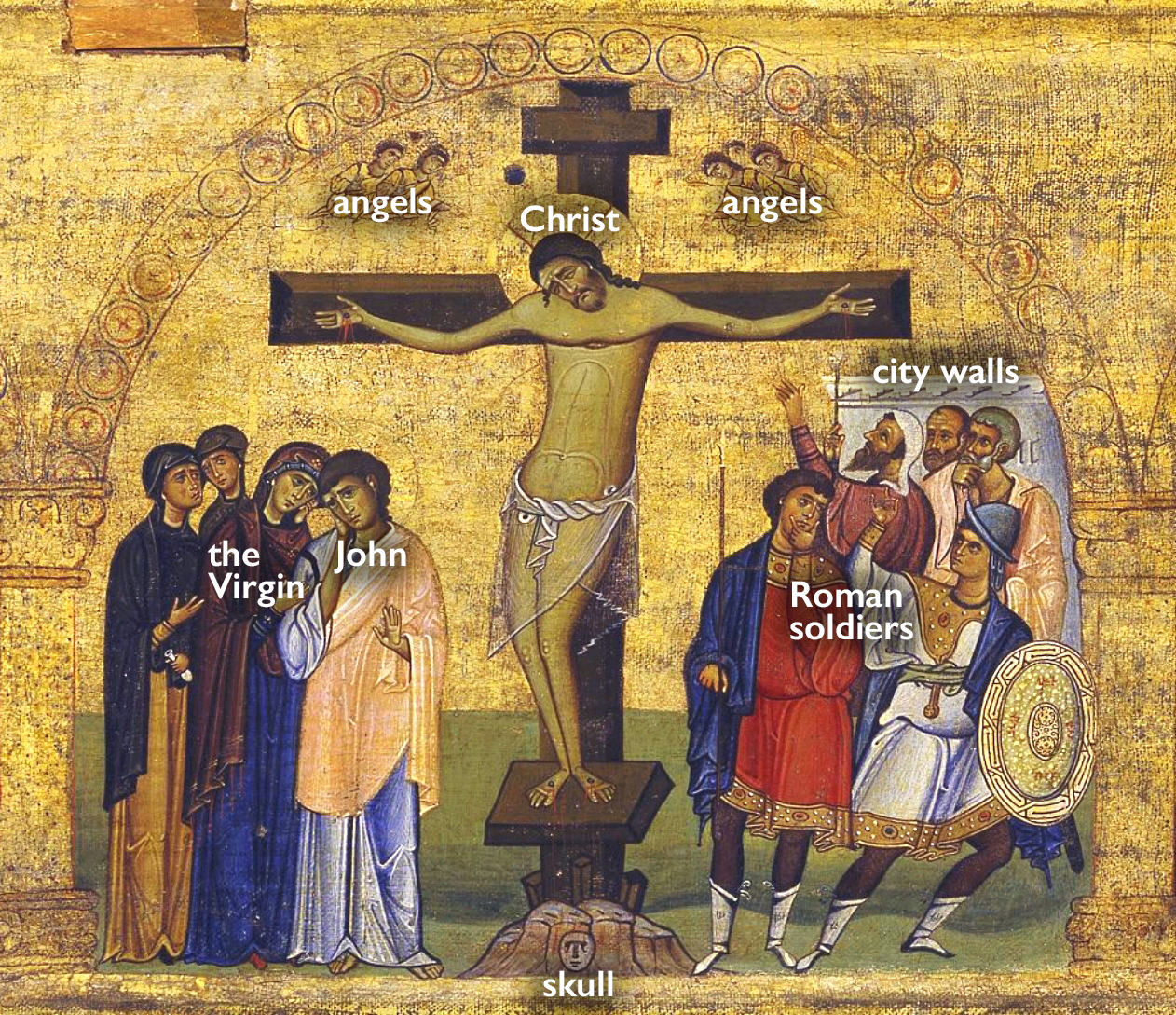
*
*
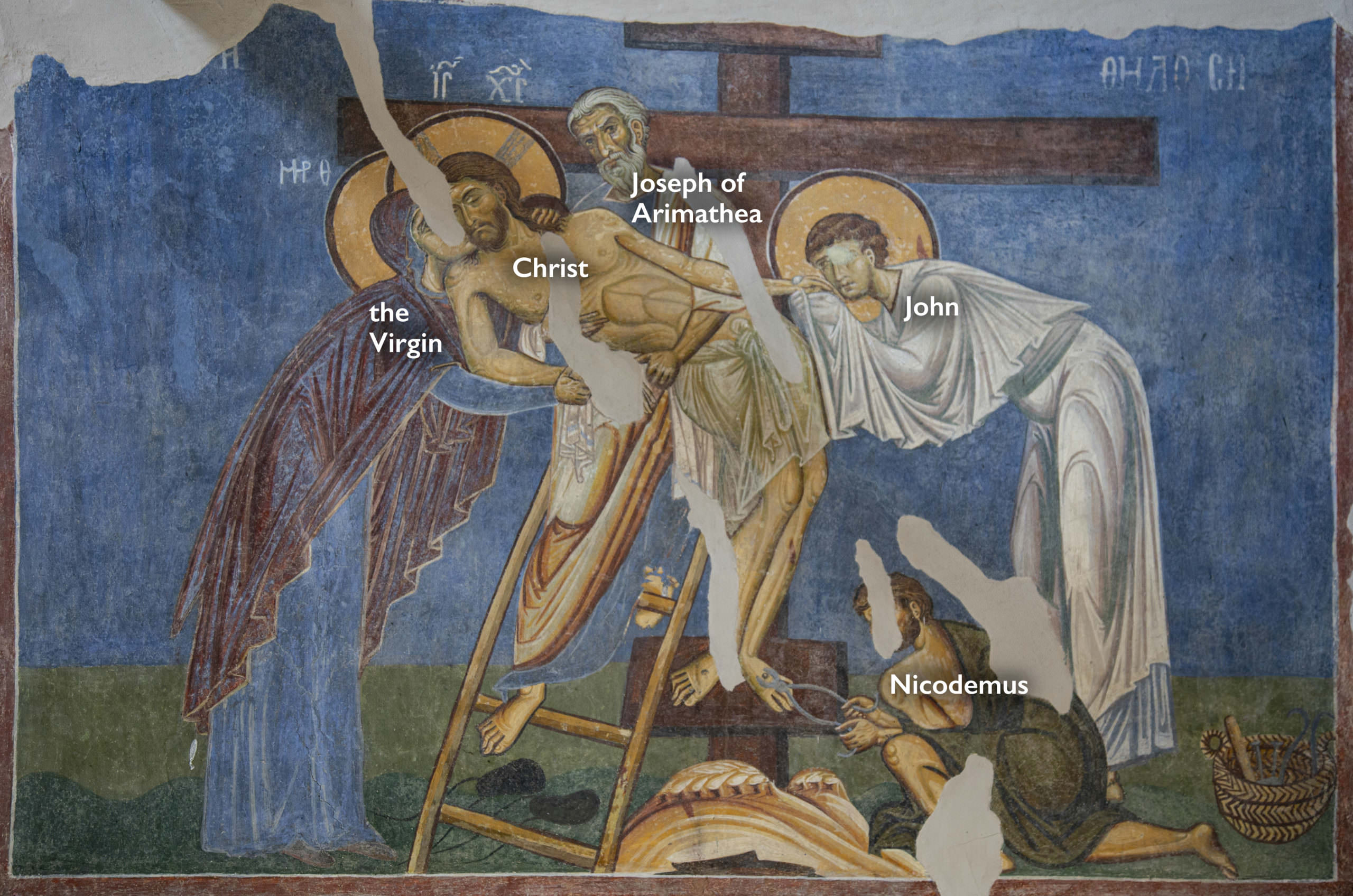
The Deposition from the Cross
The Deposition from the Cross depicts Christ’s body being removed from the cross after his crucifixion. As at the church of Saint Panteleimon at Nerezi, the composition often includes the Virgin and John the Evangelist (who were present at Christ’s crucifixion), as well as Joseph of Arimathea and Nicodemus, two followers of Jesus. It is based on Gospel accounts that describe Joseph of Arimathea burying Christ’s body in Joseph’s own tomb (Matthew 27:57-61, Mark 15:42-47, Luke 23:50-56, John 19:38-42).
*
*
*
*
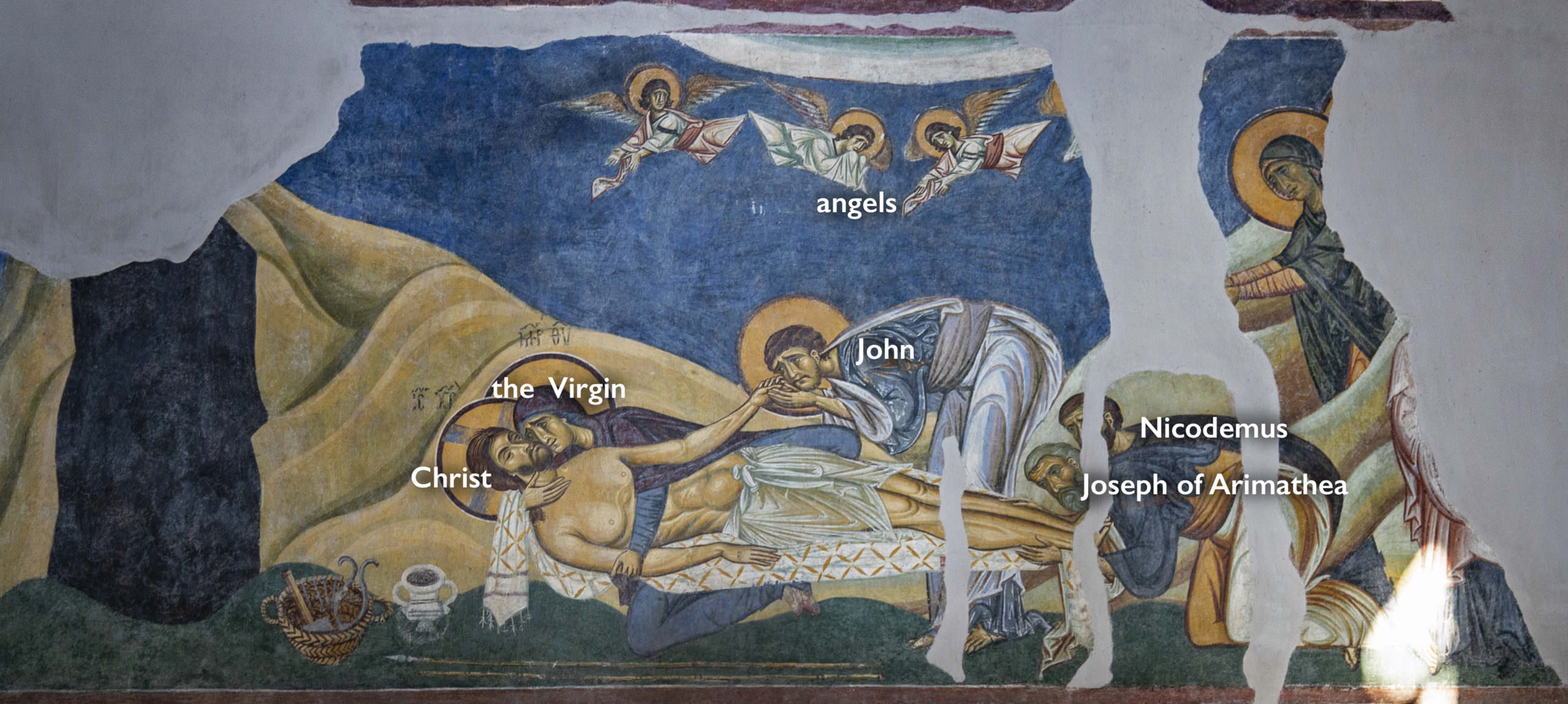
The Lamentation
The Lamentation, or Threnos, depicts Christ’s mother and other followers mourning over Christ’s dead body following the crucifixion. As at the church of Saint Panteleimon at Nerezi, the Lamentation often includes John the Evangelist (who was present at the Crucifixion), as well as Joseph of Arimathea and Nicodemus, two followers of Jesus who helped remove his body from the cross and bury him.
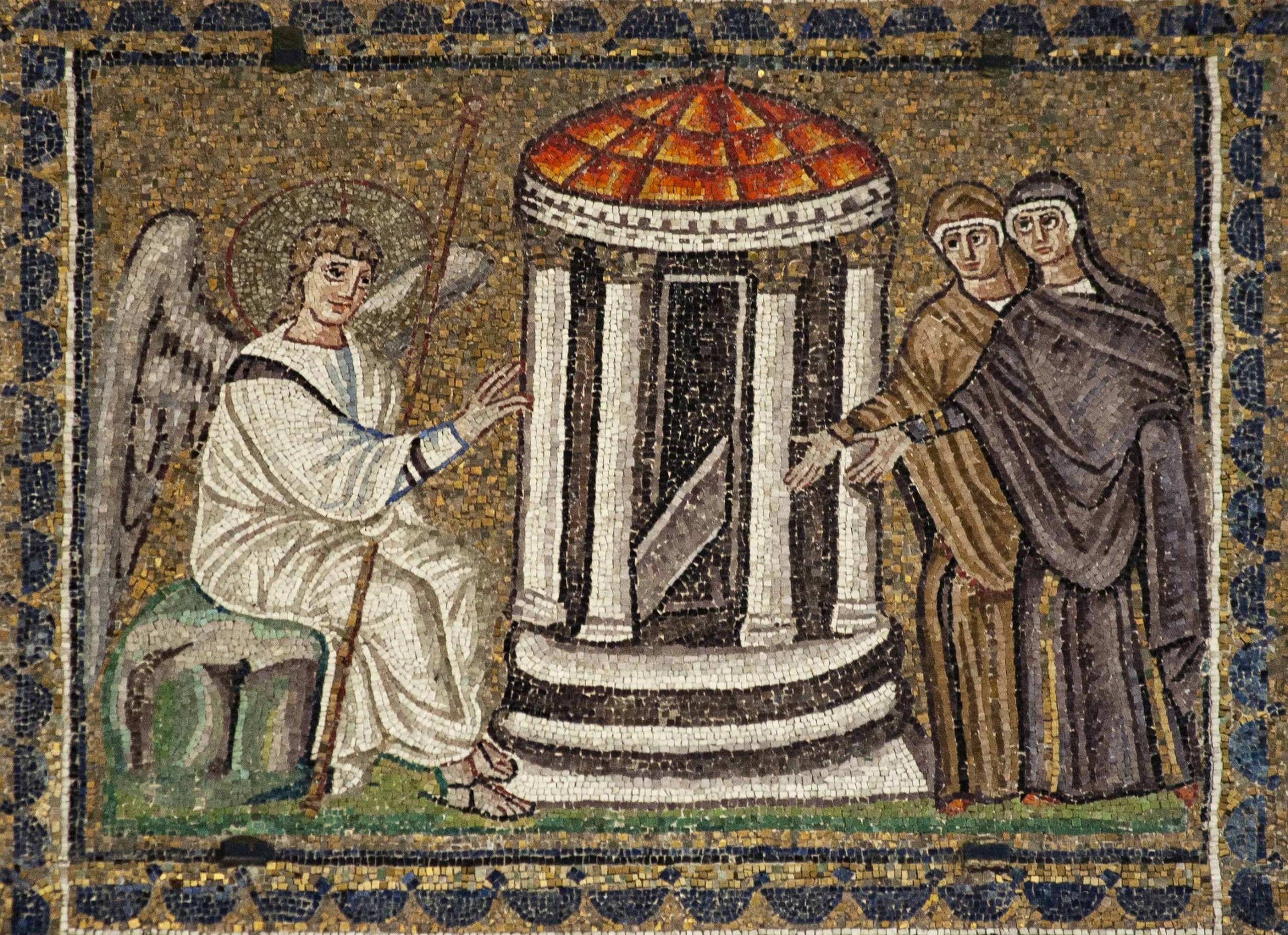
The Resurrection
The Resurrection of Christ from the dead occurred on the third day after his crucifixion according to New Testament accounts, and is celebrated each year on Pascha (Easter). The Gospels describe women who followed Jesus as the first witnesses to Christ’s resurrection: Matthew 28:1–10; Mark 16:1–8; Luke 23:55–24:12; John 20:1–18. Early Christian art depicts the myrrhbearing women bringing spices to anoint Christ’s body but discovering that the tomb is empty. An angel tells them that Christ has risen from the dead. At Sant’Apollinare Nuovo, the empty tomb is envisioned as a rotunda, likely a reference to the Roman emperor Constantine’s Church of the Holy Sepulchre that marked the site of Christ’s resurrection in Jerusalem.
*
*
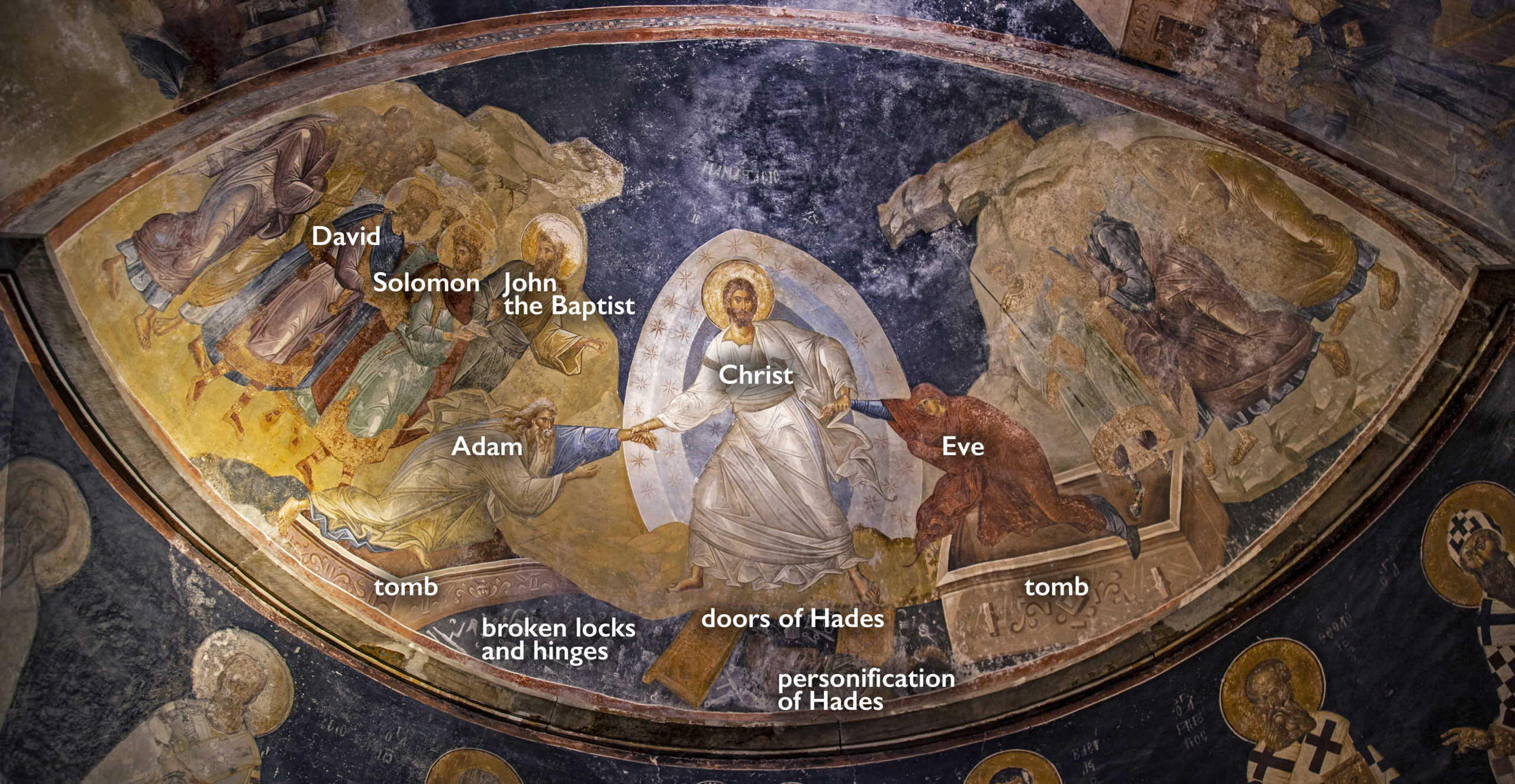
The Anastasis
The Anastasis (Greek for “resurrection”), also known as the “Harrowing of Hades” or “Harrowing of Hell,” became a standard resurrection composition from the eighth century onward. Based largely on non-biblical sources, the scene shows Christ descending into Hades (the underworld)—sometimes carrying his cross as an instrument of salvation—to raise the dead from their tombs. Locks and hinges lie broken underfoot as Christ tramples the broken gates of the underworld that once imprisoned the dead. In some images, Christ also tramples the personified figure of Hades, who represents death. At the Chora Monastery, Christ reaches with both hands to raise Adam and Eve (the first humans) from their tombs. Righteous figures from the Hebrew Bible and Christian New Testament—usually David, Solomon, and John the Baptist—stand nearby. The image corresponded with the chief hymn of Pascha (Easter): “Christ is risen from the dead, trampling down death by death, and upon those in the tombs bestowing life!”
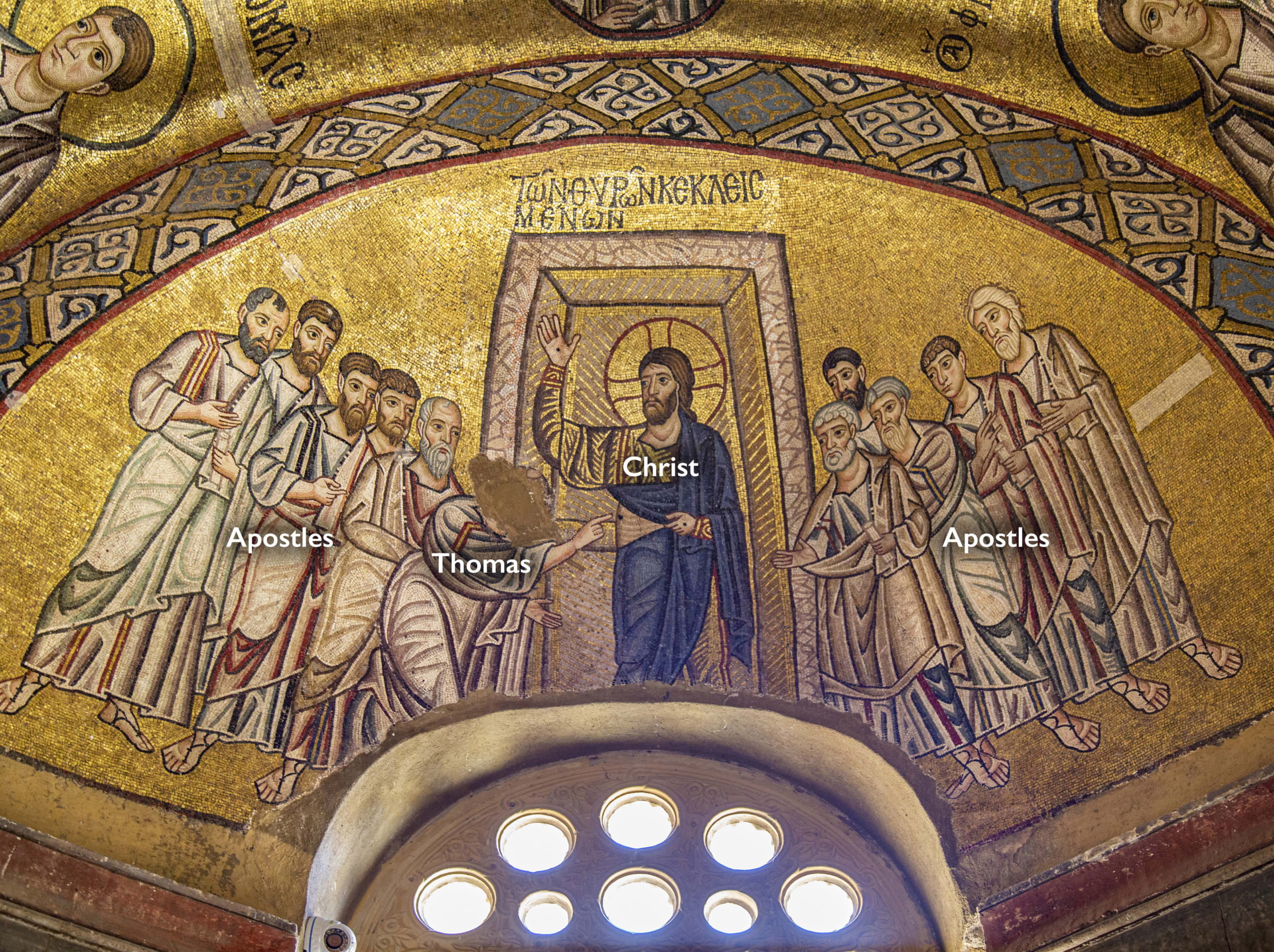
The Incredulity of Thomas
The Incredulity of Thomas appears in John 20:24–29, and is commemorated in the Eastern Orthodox Church the Sunday after Pascha (Easter). When some of the disciples claim to have encountered the risen Christ, the Apostle Thomas expresses doubt, stating: “Unless I see the mark of the nails in his hands, and put my finger in the mark of the nails and my hand in his side, I will not believe” (John 20:25). A week later, Jesus appears and invites Thomas to touch his wounds: the moment depicted in this mosaic at Hosios Loukas Monastery. Thomas exclaims: “My Lord and my God!” (John 20:28).
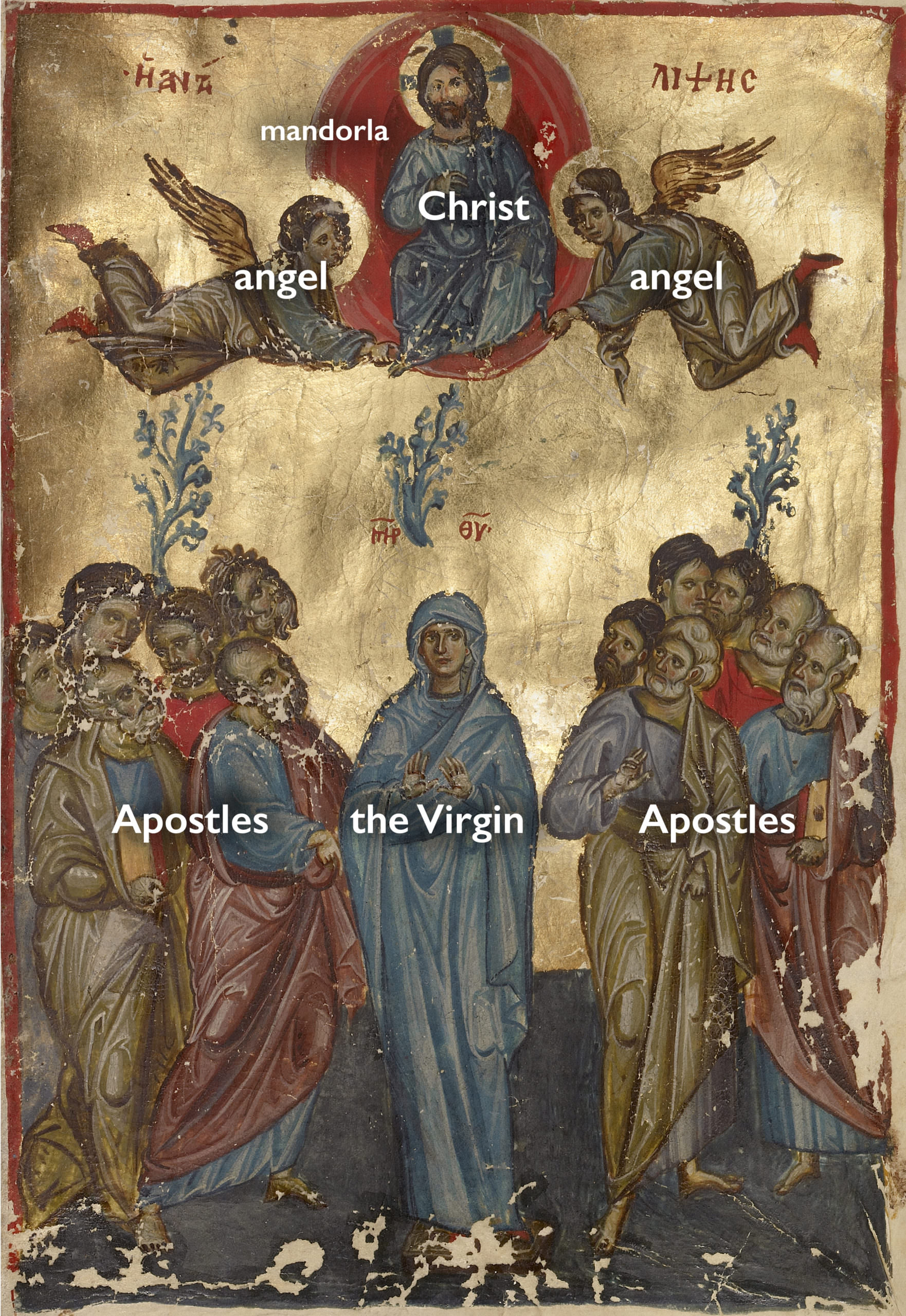
The Ascension
The Ascension of Christ into heaven, following his resurrection from the dead, is described in Luke 24:50–53 and Acts 1:9–12 and is commemorated on the Thursday that falls forty days after Pascha (Easter). The iconography derives from pre-Christian imperial apotheosis scenes (for example, on the Arch of Titus in Rome). Christ appears within a mandorla and is borne heavenward by angels, as seen in the miniature from the Getty Museum. The Virgin and Apostles stand on earth below. The ascension often appeared in church vaults, corresponding with the Byzantine interpretation of the church as a microcosm with the vaults representing the heavens.
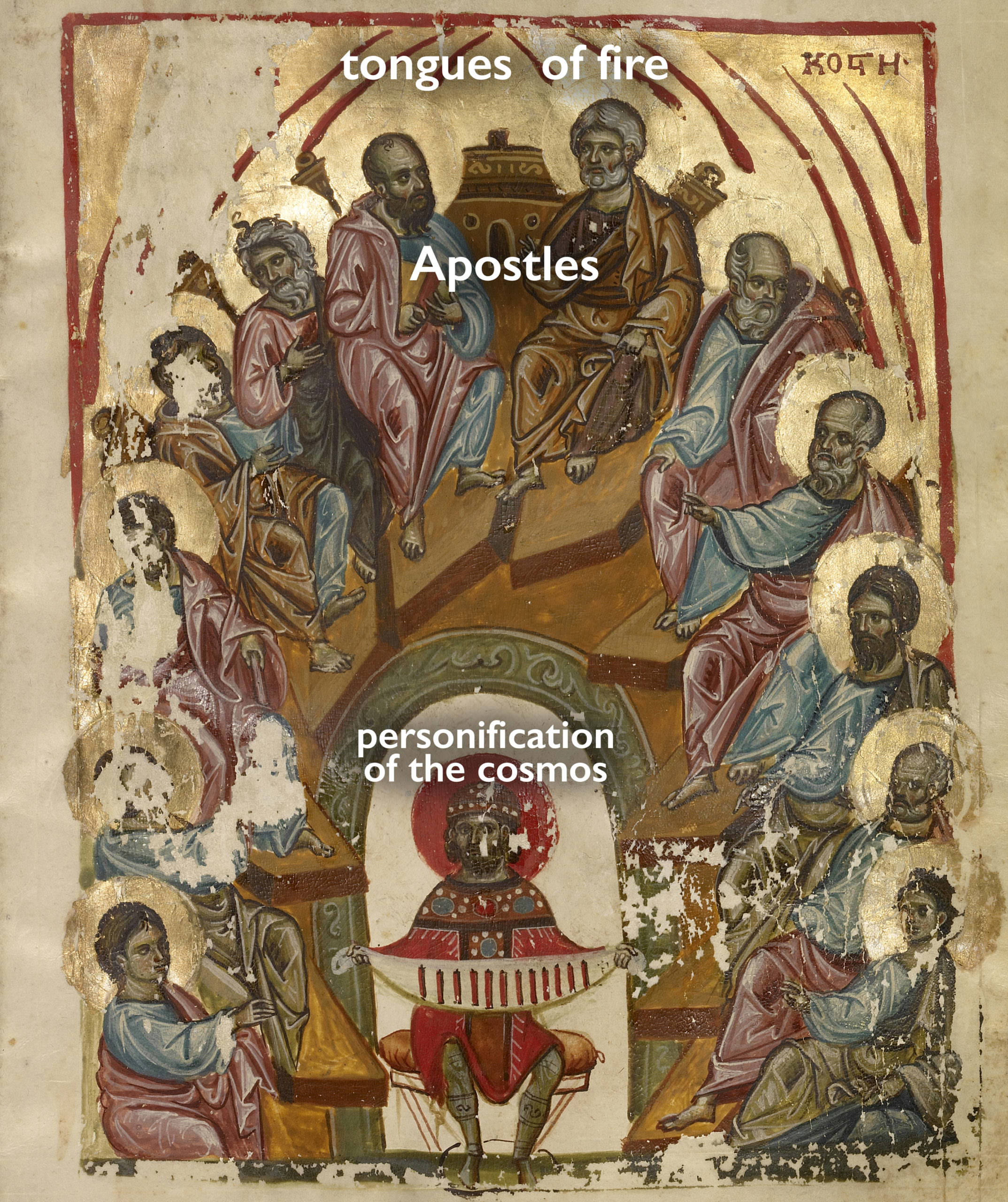
Pentecost
Pentecost (literally “the fiftieth day”) depicts the descent of the Holy Spirit on the Apostles as described in Acts 2 and is commemorated fifty days after Pascha (Easter). The Holy Spirit takes the form of tongues of fire. Sometimes the Virgin appears with the Apostles, although she is not present in the biblical account. In Acts, the Holy Spirit inspires the Apostles to preach the crucified and risen Christ in different languages so that all can understand. In artistic representations of the event, figures representing different “tribes” and “tongues,” or a single figure personifying the entire “cosmos,” (seen in this miniature from the Getty) receive the Apostles’ words. Sometimes, the “prepared throne” (Hetoimasia) is included as the source from which the flames descend.
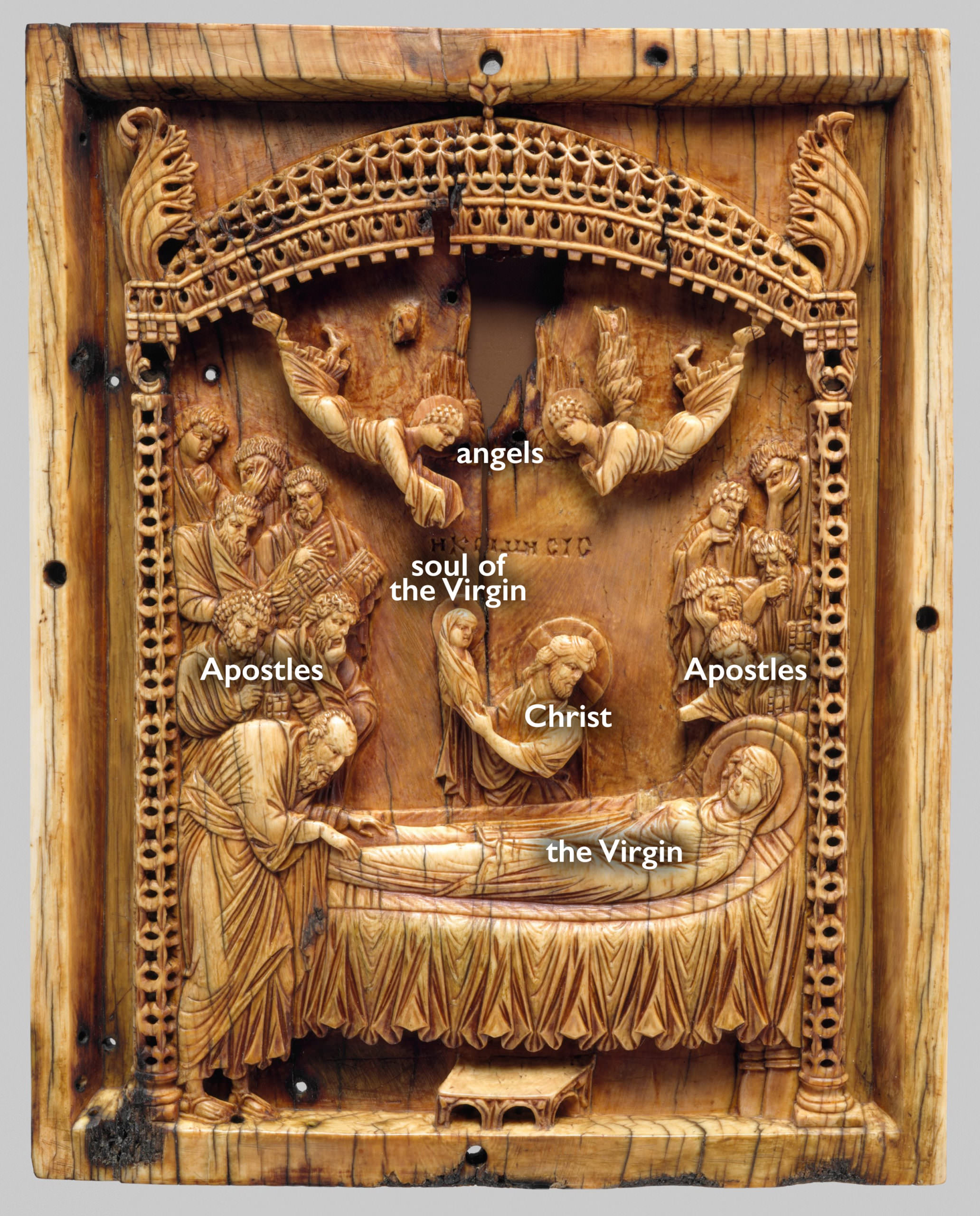
The Dormition
The Dormition (Greek: Koimēsis, literally “falling asleep”) represents the death of the Virgin Mary, described in non-biblical texts and commemorated on August 15. The Virgin lies on her funeral bier surrounded by the Apostles. Christ stands behind the Virgin, receiving her soul, which takes the form of a swaddled infant. Later icons sometimes include additional details such as the Apostles miraculously borne to the scene on clouds and the gates of heaven opening to receive the Virgin. Tenth-century ivories from Constantinople like this one are among the earliest depictions of the Dormition.
